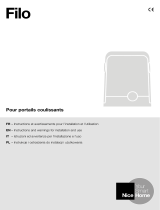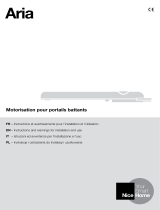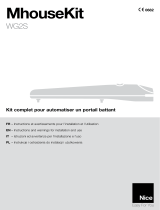Page is loading ...

FR - Instructions et avertissements pour l’installation et l’utilisation
EN - Instructions and warnings for installation and use
IT - Istruzioni ed avvertenze per l’installazione e l’uso
PL -Instrukcjeiostrzeżeniadoinstalacjiiużytkowania
Sole
KIT
Kit alimentation solaire
pour motorisations de portail

0
100
200
300
400
500
600
700
800
0°(Eq)
15°N
30°N
40°N
45°N
50°N
60°N
DecNovOctSepAugJulJunMayAprMarFebJan
–––––––––––––––“Am” –––––––––––––––
AA
0
100
200
300
400
500
600
700
800
0°(Eq)
15°S
30°S
40°S
45°S
50°S
60°S
DecNovOctSepAugJulJunMayAprMarFebJan
–––––––––––––––“Am” –––––––––––––––
BB

1 – English
English
GENERAL SAFETY WARNINGS AND PRECAUTIONS
The design and manufacture of the devices making up the
product and the information in this manual fully comply with
current standards governing safety. However, incorrect
in stallation or programming may cause serious physical injury
to those working on or using the system. For this reason, dur-
ing installation, always strictly observe all instructions in this
manual.
Ifinanydoubtregardinginstallation,donotproceedandcontactthe
NICETechnicalAssistanceforclarications.
WORKING IN SAFETY!
Warning – for personal safety it is important to observe these
instructions.
Warning – Important instructions for safety - therefore keep
these instructions in a safe place to enable future product
maintenance and disposal procedures.
Observe the following warnings:
– make electrical connections exclusively as envisaged in this
manual incorrect: connections could cause serious da mage
to the system.
– The cables supplied must be used indoor and in protected
environments. For use outdoors, the cables must be protect-
ed with adequate ducting.
– never touch the battery connector contacts with metal
objects.
Considering the risk situations that may arise during instal-
lation phases and use of the product, the devices supplied
in the pack must be installed in observance of the following
warnings:
–nevermakeanymodicationstopartofthedevicesotherthan
thosespeciedinthismanual.Operationsotherthanasspecied
cancausemalfunctions.Themanufacturerdeclinesallliabilityfor
damagecausedbymakeshiftmodicationstotheproduct.
– never place devices near to sources of heat and never expose
tonakedames.Thismaydamagesystemcomponentsandcause
malfunctions,reorhazardoussituations.
– ensure that the devices cannot come into contact with water or
other liquids. During installation ensure that no liquids penetrate the
devices present.
– the product packaging material must be disposed of in full obser-
vance of current local legislation governing waste disposal.
KNOWLEDGE OF THE PRODUCT AND PREPARATION FOR INSTALLATION
CHAPTER 1 – DESCRIPTION AND INTENDED USE
SoleKIT is a solarpowersystem designed for use with Nice Home
automations for gates, garage doors, sun awnings and similar prod
-
ucts (g. 1).
Any other use is to be considered improper! The manufac-
turer declines all liability for damage resulting from improper
use of the product and other than as specied in this manual.
Thissystemusesexclusivelysolarpowertorunanautomation,with-
out the use of electrical mains power.
Itcansupplyelectricalenergycontinuouslyandpermanentlyand
canbeusedanywhere(forexampletoautomateagatesituatedfar
from the electrical mains).
Thesystemcomprisesaphotovoltaicpanelandanelectricbattery:
– the photovoltaic panelisadeviceabletoconvertsolarenergy
directlyintoelectricalenergy.
– the battery is a device that stores the electrical power produced
bythephotovoltaicpanelduringthehoursofsunlight,makingit
availableatanytimeoftheday,includingdayswithbadweather.A
Led on the front section and an internal buzzer indicate the various
charge/dischargeconditionsoftheinternalbattery.
Therearofthebatteryisttedwith4holesforwall-mounting.The
batterycanbexedpermanentlyorsuspendedonhookstoenable
futureremovalandtransport.Tofacilitatetransport,ahandleistted
and two separable connectors to enable quick detachment of the
panel and automation.
CHAPTER 2 – COMPONENTS TO SET UP A COMPLETE POW-
ER SUPPLY SYSTEM
Fig. 2 illustrates all components used to set up a complete power
supplysystem.Thecomponentsare:
a) Photovoltaicpanelmod.SoleKITB;
b) Bracketforxtureofthephotovoltaicpanel;
c) Metalhardware(screws,washers,etc.);
d) Electricbattery(mod.SoleKITB);
e) Powercableforconnectionbetweenthebatteryandautomation;
f) “L”typeconnectors;
g) Screwsfor“L”typesocketxture.
• Optional Accessories (not supplied in pack)
SoleKITenablescompleteautonomyofsystempower,providedthat
itisusedwithinthelimitsasspeciedinchapter3.
If these limits are exceeded, for example due to intensive use of the
automation,theenergyreservemaynotbesufcient.
Inthesecasesapowersupplyunitisavailable,(modelPBC2),for
provisional connection to the electrical mains and rapid recharging
ofthebattery.
CHAPTER 3 – PRELIMINARY INSTALLATION CHECKS AND
PRODUCT APPLICATION LIMITS
ToestablishsuitabilityofSoleKITwithrespecttotheautomation
to be powered, the checks described in this chapter must be per-
formed.
Alsocheckinthechapter“Producttechnicalspecications”thatthe
technical data of SoleKIT are suitable for the envisaged use and refer
to the automation instruction manual (or addendums) to ensure that
operation of the automation is envisaged with SoleKIT. Caution! -
Simplepresenceofaconnectorforbatterypowersupplydoesnot
implycompatibility.ProductscompatiblewithSoleKIThavebeen
explicitlydesignedtoreducepowerconsumptiontoaminimum
whentheautomationisstationary,whereasaproductthathasnot
beenoptimisedforsuchapplications,mayfeaturelowconsumption
butrisksexcessiveconsumption,alsowhenstationary,oftheenergy
generatedbytheSoleKITpanel.
Inthevicinityoftheautomationtobepowered,locatetheidealpoint
forinstallationofthephotovoltaicpanelandthebattery,takinginto
consideration the following restraints.
a)theapplicationlimitsspeciedinthischapter;
b) the length of the power cable (3 m) and the cable of the photovol-
taicpanel(3m);
c)thespaceavailableinthevicinityoftheautomationtobepowered.
Alsocheckthefollowing:
d)ensurethattheselectedsurfacesforxingthetwodevicesare
solidandguaranteeastablexture.
e) ensure that each device to be installed is in a sheltered location
Instructions translated from Italian

English – 2
English
and protected against the risk of accidental impact.
f)inparticular,foreachdeviceensurethefollowing:
Photovoltaic panel
Ensure that the selected panel installation site guarantees 100%
directexposuretodirectsunlight(fullsun)everydayoftheyear.In
particular, ensure that the panel installation site is far from vegeta-
tion,wallsorothersituationsthatmaycreateshadeonthepanel.
Caution! – the sensitive surface must be exposed to direct
sunlight in all points; partial shade, even if small in size (for
example caused by a leaf or other object) will signicantly
re duce the power capacity of the panel.
Also,afterinstallation,checkthepossibilityofcorrectlyposition-
ing and inclining the panel, with reference to the instructions in
chapter 5.
Battery
Toensureoptimalefciencyofthebatteryandprolongedlifetime,
it should be installed in a location protected against high summer
temperatures and low winter temperatures.
In fact the battery charge performance depends on the ambi-
enttemperaturewherethebatteryisinstalled;optimalefciency
isensuredataround20°Cwhilethisisreducedattemperatures
be low zero.
Ontheotherhand,batterylifetimeisinuencedaboveallbyhigh
summer temperatures (above 40°C), which accelerate part age-
ing.Normallytheaveragelifetimeisapprox.4-5years;thisalso
dependsontheintensityofautomationuse.Theidealsituationis
toavoidexcessivedischargingofthebatteryduetoveryfrequent
andrepetitivemanoeuvrecyclesoverperiodsoftime.
• Application limits: Maximum possible number of cycles per
day within a set period of the year
SoleKITenablescompleteautonomyofthesystemitpowers,while
theaverageenergyproducedbythephotovoltaicpanel(whichin
turnisproportionaltothatsuppliedbythesun)remainsabovethat
consumedbytheautomation.
A simple calculation enables an estimate of the maximum number
ofcyclesperdayperformedbytheautomationinacertainperiodof
theyear,providedthatapositiveenergybalanceismaintained.
Therstpartofthecalculation(energy available) is dealt with in this
chapter, the second part of the calculation (energy consumed, i.e.
themaximumnumberofcyclesperday)isdealtwithintherespec-
tive chapter in the automation instruction manual.
Caution!-NotallautomationsproducedbyNICEarecompatible
with SoleKIT. If the automation instruction manual (or addendums)
does not contain the chapter with the calculation of the maximum
numberofcyclesobtainablewithenergysuppliedbySoleKIT,this
means that the automation is not compatible.
Calculating the energy available in a set period of the year
Tocalculatetheenergyavailableinasetperiodoftheyear,proceed
asfollows(thecalculationalreadytakesintoaccounttheefciencyof
thephotovoltaicpanelandbatteryperformance):
01. Fig. 19showstheaveragequantityofsolarpowerradiatedby
thesuntotheearthwithinoneyear.The7outlinedareasshow
thatthequantityofenergydiffersfromzonetozone,duetoa
number of factors such as latitude, presence of clouds etc.
– Therefore, in g. 19 read value “Ea” of the average annu-
alenergy,availableinyourgeographicalarea,aswellasthe
de grees of latitudeofyourgeographicallocation.
02. As well as the measured value “Ea”, the variable progress of
energyavailableinthevariousperiodsoftheyearmustbe
takenintoaccountwithreferencetothespeciczone.Infact,
thequantityofenergyvaries(increases/decreases)according
to the seasons (see the curves in graphs AA and BB):inthe
mo nths with more exposure to sunlight (summer) much more
energyisavailablewithrespecttowintermonths;thisdiffer-
ence is less evident in the zones closer to the equator and more
accentuated in the zones closer to the terrestrial poles.
– Therefore, to calculate the lowest number of manoeuvre
cyclesperday,refertograph AA (for zones north of the equa-
tor) or graph BB (for zones south of the equator) and select
the curverelatedtoyourlatitudeandtheperiodoftheyearwith
least exposure to sunlight (corresponding to the lowest point of
the curve). Then cross reference the two values, as shown in
the example on the graph, to obtain the value “Am” (radiation
within a set period).
03. Then calculate the value “Ed”,i.e.theenergyavailableinyour
zonewithinthesetperiodoftheyear,multiplyingthevaluesas
follows:Ea x Am = Ed.
04. Lastly,tocalculatethemaximum possible number of cycles
per day, for the selected period, calculate using the value
“Ed”obtained(energyavailable)accordingtotheinstructionsin
thespecicchapteroftheautomationinstructionmanual.
Warning –Duringtheday,ifthephotovoltaicpanelremainsinthe
shadeforacertainperiodoftime(inparticularfrom10amto2pm)
theenergyavailabledecreasesinproportiontothehourswithout
panel exposure to sunlight.
CHAPTER 4 – BATTERY DISCHARGE
The previous chapter describes how to calculate the maximum num-
berofautomationcyclesperday.Thisisanestimatebasedonthe
averageenergyavailablewithintheperiodofoneyear.Intheevent
oflongperiodsofparticularlyadverseweatherconditionsorwhen
moremanoeuvresarerequiredthanthoseusuallyadmitted,the
storedenergymayrunout.
Whenthisoccurs,theledonthebatteryindicatesthebatterydis-
chargedstatuswithoneashatregularintervals(approx.5seconds)
andbeepsemittedintimewiththeLed:thissignalmaybetempo-
raryorpermanent.Inbothcases,thebatterymustberecharged
accordingtooneofthefollowingprocedures:
A)rapidrechargeofbatteryusingpowersupplyunitmod.PBC2
(optionalaccessory);
B) limit use of the automation until the weather conditions improve
andenablerechargingofthebatteryviathephotovoltaicpanel.In
bothcases,the“batterydischarged”warningisclearedwhenthe
systemreachessufcientelectricalautonomytoenableautomation
operation.

3 – English
English
COMPONENT ASSEMBLY AND CONNECTIONS
CHAPTER 5
STEP 1 – Assembly of photovoltaic panel support bracket
Assemble all components of the support bracket on the rear of the
panel, as shown in g. 3.
Caution! – The bracket at the rear of the panel must be positioned
(g. 3-b)accordingtothetypeofpositioninwhichthepanelis
mounted. To select the position, refer to g. 6.
STEP 2 – Photovoltaic panel positioning
Caution! – For optimal operation of the panel, it must be
positioned precisely in the selected location. Therefore, after
performingthechecksasdescribedinchapter3,strictlyobserve
thefollowinginstructions:asageneralrule,thepanelmustbeposi-
tioned so that it can receive the maximum possible sunlight during
thedayandthroughouttheyear.Thismeansthatitshorizontalposi-
tion and vertical angle must be calculated on the basis of the location
where it is to be installed.
• Ensure the correct position of the panel on the horizontal
planeasfollows:
a) In the installation site, determine the cardinal points NORTH and
SOUTH, with the aid of a compass or a geographical map of the
location.
b) Then position the panel in the direction NORTH or SOUTH,
accordingtothefollowing:
– if the installation site is in a country North of the equator
(UnitedStates;Europe;Russia;etc.)thepanelmustbeposi-
tioned exactly SOUTH;
– if the installation site is in a country South of the equator
(LatinAmerica;Australia;Indonesia,etc.)thepanelmustbeposi-
tioned exactly NORTH.
For further information, refer to g. 4.
• Ensure the correct position of the panel on the vertical plane
asfollows:
Consideringthatitispreferabletoensuremaximumefciencyofthe
panelduringthewinterperiod,whenthereislessenergyavailable
than in the summer, the panel should be positioned at an angle that
ensuresreceptionofthesunraysperpendicular(fromfront)tothe
sensitive surface.
This angle corresponds to the latitude of the location and can be
readonanycommercialgeographicalmap.Forexample,Madrid
hasalatitudeof40°;Venice45°;orLondonapprox50°etc.For
further information, refer to g. 5.
STEP 3 – Fixing the photovoltaic panel in the selected site
Afterestablishingtheprecisepositionofthepanel,xtotheselected
surface as shown in g. 6.
STEP 4 – Fixing the battery in the selected site
After performing the checks as described in chapter 3 and establish-
ingtheprecisepositionofthebattery,xtotheselectedsurfaceas
shown in g. 13. Note–usethe2lowerscrewsonlyifyouwishto
anchorthebatteryinapermanentposition,i.e.whenremovalisnot
required.
STEP 5 – Cable routing
IMPORTANT! – The cables supplied must be used in
indoor and protected environments. For use outdoors,
the cables must be protected with adequate ducting.
Afterxingthepanelandbattery,routethepanelcablethroughthe
tubeorprotectionductingthroughtothebattery.
With reference to the instruction manual of the automation to be
powered, remove the control unit protection cover. Then pass the
end of the power cable (with wires exposed) through the automation
(where the other cables are routed). Then route the cable through
theprotectionducting(ifpresent)throughtothebattery.
Caution!–Donotconnectthepowercabletothecontrolunit;leave
access to the control unit open.
STEP 6 – Assembly of “L” socket on the photovoltaic pa nel
cable
If the cable is too long, it can be shortened, taking care to strip the
wires so that their length is equaltothevaluesspeciedintheg.
20 (caution! –differentlengthsmayimpairsubsequentassemblyof
the socket).
ThenproceedwithassemblyoftheGREY “L”typesocketonthe
endofthepanelcable,asfollows:
01. Insert the various elements of the socket on the cable, taking
care to observe the sequence as shown in g. 7;
CAUTION! – Do not modify the electric jumper on the connec-
tor (g. 8).
02. Using a slotted screwdriver, attach the blue wire to terminal
n° 1 on the connector and the brown wire to the earthing
terminal (4) (g. 9):
Note–Thereferencenumbersandsymbolsareprintedonthe
connector below the terminals and on the opposite side.
03. Afterxingthetwowires,inserttheconnectorinitscasing
(g. 10).
Important – The correct position of the connector is that
with the earthing symbol in the lower position (see g. 10);
04. Then pull the cable outwards from the socket and insert the
seal and washer (g. 11-a-b).Lastly,tightenthecableclamp
(g. 11-c) using a wrench, toguaranteecompletelysealedclo-
sure.
05. After assembling the socket, position the seal supplied on the
connection side (g. 12).
STEP 7 – Assembly of “L” socket on the power cable
If the cable is too long, it can be shortened, taking care to strip the
wiressothattheirlengthisequaltothevaluesspeciedintheg.
20 (Caution!–differentlengthsmayimpairsubsequentassemblyof
the socket).
ThenproceedwithassemblyoftheBLACK“L”typesocketonthe
endofthepowercable,asfollows:
01. Insert the various elements of the socket on the cable, taking
care to observe the sequence as shown in g. 7;
CAUTION! – Do not modify the electric jumper on the connec-
tor (g. 8).
02. Using a slotted screwdriver, attach the blue wire to terminal
n° 1 on the connector and the brown wire to the earthing
terminal (4) (g. 9):
Note –Thereferencenumbersandsymbolsareprintedonthe
connector below the terminals and on the opposite side.
03. Afterxingthetwowires,inserttheconnectorinitscasing
(g. 10).
Important – The correct position of the connector is that
with the earthing symbol in the lower position (see g. 10);
04. Then pull the cable outwards from the socket and insert the
seal and washer (g. 11-a-b).Lastly,tightenthecableclamp
(g. 11-c) using a wrench, toguaranteeacompletelysealed
closure.
05. After assembling the socket, position the seal supplied on the
connection side (g. 12).
STEP 8 – Connecting the photovoltaic panel to the battery
Toconnectthepaneltothebattery,proceedasfollows:
01. Connect the GREY“L”typesockettothe“IN” connector on
thebattery(g. 14);
02. Toselectthemostsuitableconnectioncongurationforthe

English – 4
English
connectionofallsystemdevices,refertotheexampleshownin
g. 15. Note–Iffrequentdisconnectionofthebatteryplugis
envisaged, use the screw in g. 16-a. Otherwise use the screw
in g. 16-b.
Caution!-Whenthebatteryisrechargingviathephotovoltaicpanel,
theredledemits2shortashesevery5seconds.Thereforecheck
that this signal is present when the panel is exposed to the sunlight.
STEP 9 – Connecting the battery to the automation
Toconnectthebatterytotheautomation,proceedasfollows:
01. Connect the BLACK“L”typesockettothe“OUT” connector
onthebattery(g. 17);
02. Toselectthemostsuitableconnectioncongurationforthe
connectionofallsystemdevices,refertotheexampleshownin
g. 18. Note – Iffrequentdisconnectionofthebatteryplugis
envisaged, use the screw in g. 16-a. Otherwise use the screw
in g. 16-b.
03. Access the control unit of the automation and insert the pow-
ercableconnectorinthebufferbatterysocketonthecontrol
unit. To locate this socket, refer to the instruction manual of the
automation to be powered.
Caution! - when the automation is powered by SoleKIT, it
must NEVER BE POWERED via the mains at the same time.
–– General note ––
IMPORTANT – After connecting the product to the automation,
thesystemmaynotbeoperativeimmediately;thisdependson
thefactthatthebatterymaybedischargedduetothenatural
process of discharging over time, even when stored. In this case,
therearetwowaystoproceed:
A)Disconnectthebatteryfromtheautomationcontrolunitand
waitforafewdaysforthephotovoltaicpaneltoreceivesufcient
sunlightinordertorechargethebattery;
B) Proceedwithrapidrechargeofbatteryusingback-uppower
supplyunitmod.PBC2(optionalaccessory).
–– Visual and audible signals ––
The SoleKIT is equipped with a led and a buzzer.
•Whenthebatteryisrecharging(viathephotovoltaicpanelor
batterycharger)theredledemits2shortashesevery5sec-
onds Therefore check that this signal is present, also after instal-
lation, when the panel is exposed to the sunlight.
•Whenthebatteryhascompletedchargingviathebatterycharg-
er,theledremainspermanentlylit.
•Whenthebatteryisdischarged,theredledemitsoneshort
ashevery5seconds,accompaniedbyabeep.
–– Notes for use ––
• NEVER leave the battery connected to the automation if
the photovoltaic panel is not also connected and opera-
tional.
Caution! - Ifthebatteryisnotsufcientlyrecharged,thereserve
willrunoutwithinafewdays.
• If the automation is not used for prolonged periods,
detach the connectors of the automation and photovol-
taic panel from the battery and store the latter in a cool
and dry location.
4 mm
10 mm
20

5 – English
English
WHAT TO DO IF... (troubleshooting guide)
• The automation control unit does not turn on and the led
remains off.
Thismaybecausedbyincorrectconnectionsorelectricwiresnot
fullyinserted.Otherwisethebatterymaybetotallydischarged,in
whichcasenosignalcanbesent:inthiscasearapidrechargeis
requiredbymeansofpowersupplyunit(mod.PBC2)orwaitforthe
photovoltaicpanel(connectedcorrectly)torechargethebattery.
• The battery tends to discharge too quickly.
Thismaydependonexcessiveageingofthebattery,inwhichcaseit
shouldbereplaced;otherwiseitmaybeduetoexcessivelyintensive
use of the automation, over the application limits envisaged in this
manual, found in chapter 3.
Otherwisetheautomationmaynotbecompatibleforoperationwith
SoleKIT,ortheautomationisincorrectlyconguredforlowcon-
sumption,ortoomanyaccessoriesareconnected.
• The battery no longer recharges.
Thismaybeduetoamalfunctionofthephotovoltaicpanelcaused
byincorrectinstallation,incorrectcableconnections,ormalfunction
ofthebattery.
PERIODIC MAINTENANCE OPERATIONS
Ingeneral,thisproductdoesnotrequirespecialmaintenance;how-
ever,regularchecksovertimewillensuresystemefciency.
Therefore,toensurecorrectmaintenance,checkevery6months
that the photovoltaic panel has not accumulated dirt (leaves, sand,
etc.)asthismayreduceefciency.
Alsocheckwhetherbatteryreplacementisrequired,astheageing
processreducesautonomyovertime.
Takeintoaccountthatbatterylifetimeisinuencedaboveallbyhigh
summer temperatures,whichacceleratepartageing.Normallythe
averagelifetimeisapprox.4-5years;thisalsodependsontheinten-
sityofautomationuse:Theidealsituationistoavoidexcessivedis-
chargingofthebatteryduetoveryfrequentandrepetitivemanoeu-
vrecyclesoverperiodsoftime.
CAUTION – The battery must be replaced exclusively by
skilled and qualied personnel.
DISPOSAL
Product disposal
This product is an integral part of the automation and there-
fore must be disposed together with the latter.
Asininstallation,alsoattheendofproductlifetime,thedisassembly
andscrappingoperationsmustbeperformedbyqualiedpersonnel.
Thisproductcomprisesvarioustypesofmaterials:somemaybe
recycledothersmustbedisposedof.Seekinformationontherecy-
clinganddisposalsystemsenvisagedbythelocalregulationsinyour
areaforthisproductcategory.
Caution! –somepartsoftheproductmaycontainpollutantorhaz-
ardoussubstanceswhich,ifdisposedofintotheenvironment,may
causeseriousdamagetotheenvironmentorphysicalhealth.
Asindicatedbythesymbolalongside,disposalof
thisproductindomesticwasteisstrictlyprohibited.
Separate the waste into categories for disposal,
accordingtothemethodsenvisagedbycurrent
legislationinyourarea,orreturntheproducttothe
retailer when purchasing a new version.
Theproductalsocontainsaleadbattery,i.e.anelementthatishigh-
lypollutantifnotdisposedofcorrectly.Thebatterymustberemoved
anddisposedofasspeciedintheparagraph“Batterydisposal”.
Caution! –Locallegislationmayenvisageseriousnesintheevent
of abusive disposal of this product.
Battery disposal
Caution! –Thebatterycontainspollutantsubstancesandtherefore
must NEVER be disposed of in common waste collection points after
removal.Disposeoforrecycleaccordingtocurrentlocalstandards.

English – 6
English
TECHNICAL SPECIFICATIONS OF PRODUCT COMPONENTS
WARNINGS:•TheproductSoleKITisproducedbyNiceS.p.a.(TV)I.• Alltechnicalspecicationsstatedhereinrefertoanambienttemperatureof20°C(±5°C)
•NiceS.p.a.reservestherighttoapplymodicationstotheproductatanytimeasdeemednecessary,whilemaintainingthesamefunctionalitiesandintended
use•Theestimatedminimumnumberofmanoeuvresperday,isapplicableexclusivelywiththephotovoltaicpanelpositionedcorrectlyandintheconditionsas
speciedinchapter3undertheheading“ApplicationLimits”.
CE DECLARATION OF CONFORMITY
DeclarationinaccordancewiththefollowingDirectives:2014/35/UE(LVD)and2014/30/UE(EMC)
Note – The content of this declaration corresponds to that specied in the ofcial document deposited at the Nice S.p.A. headquarters and, in particular, to
the latest revised edition available prior to the publishing of this manual. The text herein has been re-edited for editorial purposes.
A copy of the original declaration can be requested from Nice S.p.A. (TV) Italy.
Declaration number: 570/SUN Revision: 0 Language: EN
Manufacturer's Name: NICE S.p.A.
Address: ViaPezzaAlta13,31046RustignèdiOderzo(TV)Italy
Type of product: Solar power kit for gate automatisms
Model/Type: SOLEKIT
Accessories: SOLEKITC,SOLEKITB,PBC2
TheundersignedRobertoGriffa,asChiefExecutiveOfcer,herebydeclaresunderhisownresponsibilitythattheproductidentied
abovecomplieswiththeprovisionsofthefollowingdirectives:
• DIRECTIVE2014/35/EUOFTHEEUROPEANPARLIAMENTANDOFTHECOUNCILof26February2014ontheharmoni-
sationofthelawsofMemberStatesrelatingtothemakingavailableonthemarketofelectricalequipmentdesignedforuse
withincertainvoltagelimits(recast),accordingtothefollowingharmonisedstandards:
EN60335-1:2002+A1:2004+A11:2004+A12:2006+A2:2006+A13:2008+A14:2010+A15:2011
• DIRECTIVE2014/30/EUOFTHEEUROPEANPARLIAMENTANDOFTHECOUNCILof26February2014ontheharmonisa-
tionofthelawsoftheMemberStatesrelatingtoelectromagneticcompatibility(recast),inaccordancewiththefollowinghar-
monisedstandards:EN61000-6-2:2005,EN61000-6-3:2007+A1:2011
Oderzo,28July2016 Ing. Roberto Griffa
(ChiefExecutiveOfcer)
SoleKITB BATTERY
DESCRIPTION DATA
Rated voltage: 24V
Maximum current: 10 A
Rated battery capacity: 20Ah
Protection rating: IP 44
Operation temperature: from-20°Cto+55°C(whenchargingusingtheback-uppowersupplyunit:from0°Cto+40°C)
Complete recharging time: approx.15hours(whenusingtheback-uppowersupplyunit)
Dimensions: 258mmx235mmx180mm
Weight: 14 kg
Note–ThebatteriesusedonSoleKITBaretypeVRLA,“ValveRegulatedLeadAcidBatteries”,i.e.sealedandvalve-controlled,compliantwiththe
specicprovisionA67oftheIATA/ICAAORegulationgoverninghazardousproducts.SoleKITBandSoleKITarethereforenotconsideredhazardous
goodsandmaybetransportedwithoutanyriskbyair,seaandonroad.
SoleKITB PHOTOVOLTAIC PANEL
DESCRIPTION DATA
Rated voltage: 24V
Maximum power: 10 W
Operation temperature: from-40°Cto+85°C
Dimensions: 354mmx290mmx28mm
Weight: 1,4 kg
Warning–Theglassofthephotovoltaicpanelhasbeentestedtoresisttohailstonesandmediumentityimpact(resistanttoimpactwithasteel
sphereof227g,fallingfromaheightof1metre).Intheeventofparticularlyconsistenthailorimpact,theglassmaybedamaged;inthiscasecontact
the NICE Technical Assistance service.
/















